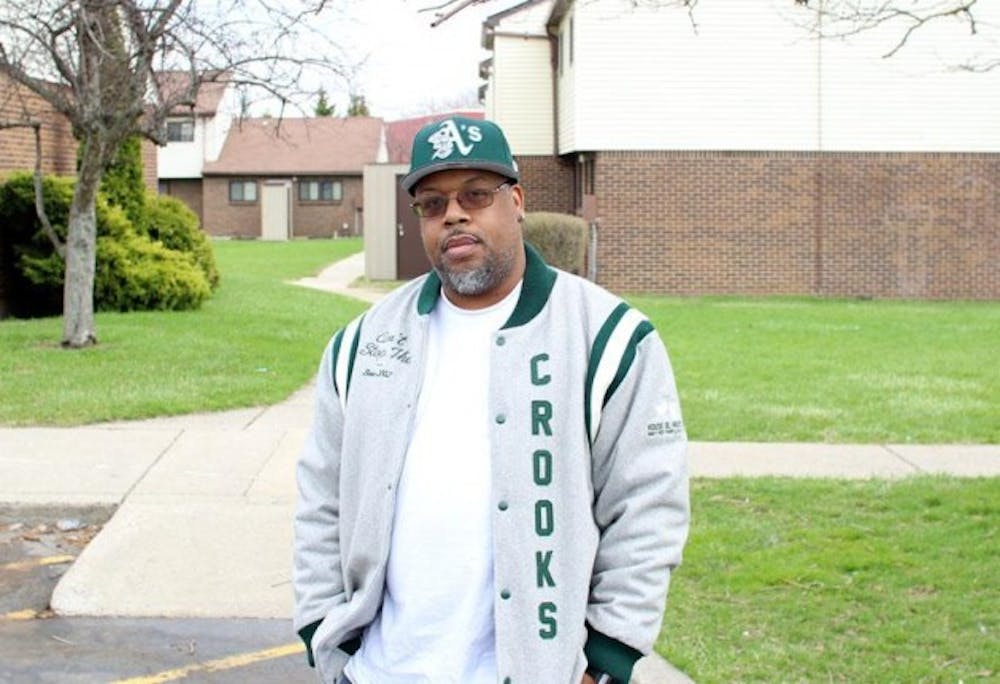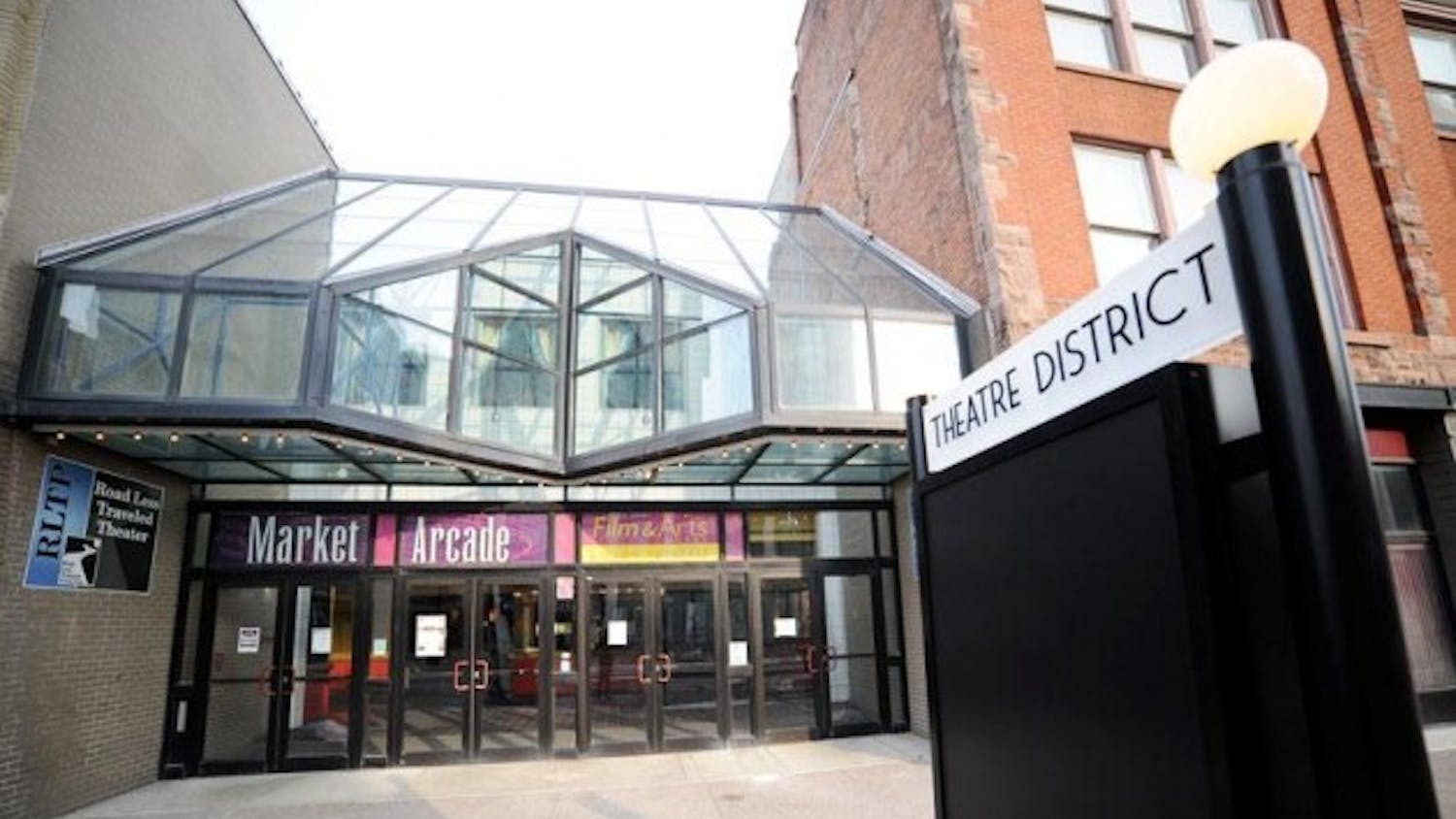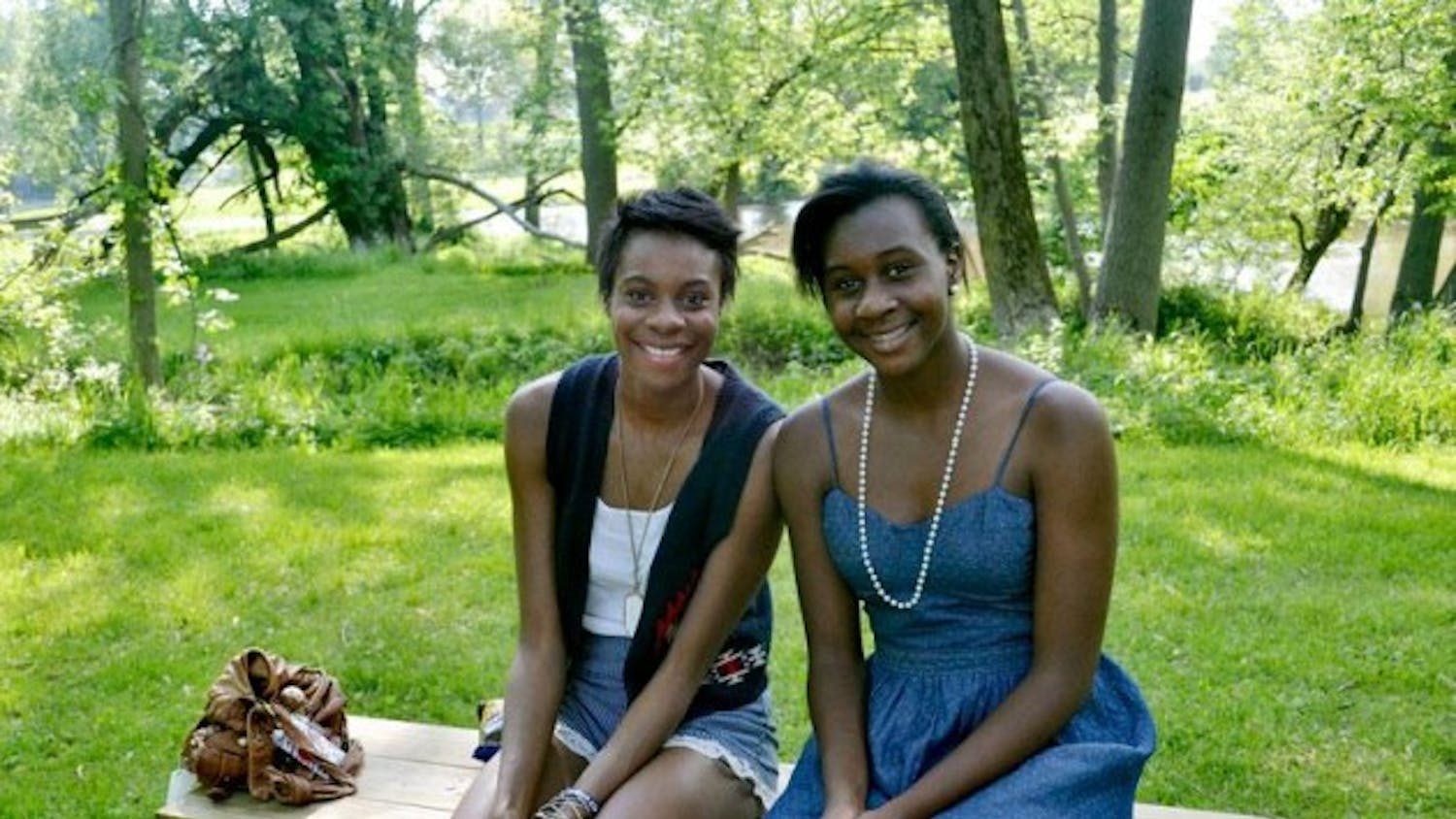It's a Friday afternoon in McCarley Gardens, a housing complex in the Fruit Belt area of the lower East Side of Buffalo. Afternoon light filters through the trees lining the red brick townhouses.
Weaving through the streets, a school bus drops off a child, who, with her backpack beating against her, runs to a group of men standing beside parked cars. Across from them, McCarley Gardens resident A.D. Cooper talks on his phone while a woman pushes a stroller with her two children to their apartment, closing the door behind her.
In the McCarley Gardens community on Michigan Avenue in downtown Buffalo, life carries on normally. In the eyes of resident Eric McGriff Jr., who grew up in the low-income housing development and has lived there for 26 years, this particular Friday is like any other day. For him, McCarley Gardens is home, where everyone knows each other and looks out for each other. Nobody gets hurt here and no house is broken into, McGriff said.
"This is what we know," he said.
Cooper agrees. A resident of the complex for 18 years, he has raised his kids here. As he takes a swig of whiskey with his neighbor, he points across the street to where he used to sled when he was a kid. This was always home for him and his family. The same basketball courts, the same families.
But there is change in the air. Across the complex, there are different sounds. Construction workers congregate in front of caution tape. Students filter in and out of Roswell Park Cancer Institute. The blue University at Buffalo emblem is hung, and metal building structures grow by the hour.
Just steps from the McCarley Gardens townhouses, the Buffalo Niagara Medical Campus (BNMC) is growing. With six facilities currently housed on the BNMC site, UB is expanding into what its website calls "a medical school for the 21st century."
The project is a part of the university's $375 million funding, which is partially paid for by NYSUNY 2020. The university is one of 14 member institutions of BNMC. Accounting for 120 acres and 6.5 million square feet, BNMC brings in one million visitors each year. Housing research centers and medical services, including Kaleida Health and the Buffalo Medical Group, BNMC, Inc. is a not-for-profit entity that oversees the actions of all 14 organizations.
Since BNMC's founding in 2001, its population has risen from 7,000 people to 12,000. With UB Medical School to open in 2016, an expected 5,000 more people will be on the grounds.
Yet for the campus' surrounding neighborhoods - with the Fruit Belt neighborhood to the east and Allentown to the west - the population is struggling. According to the dean of UB's architecture school, Robert Shibley, the Fruit Belt neighborhood contains 2,000 people, making the project an opportunity for the area to bring in revenue and new residents.
"We are building down there because it is absolutely the best thing for the relationship between health care, research and education for medical students," Shibley said. "That's our mission. At the same time, we recognize, I think, that we exist in this community that hosts us and we see the way in which our choices to do a better job at our mission, create opportunities for public policy and developers and residents to take advantage of those improvements and increasing wealth."
Three years ago, St. John Baptist Church, which owns the McCarley Gardens housing complex, proposed a $15 million deal to sell the 160-acre property to the UB Foundation, a private organization that handles all donations to the university and controls close to $1 billion of UB assets and endowment funds.
Reverend Michael Chapman, the pastor at St. John Baptist Church, refused to comment.
After outrage from community members, who went as far as sending a petition to the Buffalo Common Council, the plan was taken off of the table, according to BNMC CEO Matthew Enstice.
"On the whole, we want the neighborhoods to thrive. We will never go into the neighborhoods and redevelop the neighborhoods," Enstice said. "We will never tell them what to do. Just as our institutions are running their businesses, we are going to go to them and ask, 'How can we be helpful to you?' That's the role we play right now. "
Many residents were not aware that the plan to tear down McCarley Gardens, which surfaced in June 2013, is now off the table.
"I hear they will tear down houses. For a lot of poor people, it's a nice place to live," said 67-year-old Ana Rodriguez, who has been living in the housing complex since February.
Rodriguez, who lives with her granddaughter while being treated at Roswell Park Cancer Institute for a lung issue, thinks the residents will have to be moved somewhere else if BNMC needs the land. As she walked around the grounds with her dog, Bruno, and spoke with neighbors, she said she enjoys living in the complex.
Down the block, resident Efigenia Orellana stood inside the screen door with her toddler grandson, Gavin. Orellana, who has lived in McCarley Gardens for seven years, resides across the street from St. John. She does not speak much English but said she enjoyed the "quiet, passive" community and hopes to live there for a long time.
"The idea of just sweeping those people aside for this development doesn't sit well with me, and it doesn't sit well with people who care about vulnerable populations," said Dr. Kelly Patterson, an assistant professor in the UB School of Social Work who used to teach in UB's School of Architecture andPlanning.
Patterson pointed out the risks associated with the expansion of the medical campus and "eds and meds," or educational and medical institutions. Describing herself as a "social planner," she focuses on community development and vulnerable populations in her research. Her recent work has emphasized McCarley Gardens.
She recognizes the positive impact the medical campus expansion could have on the local economy and for the City of Buffalo. For her, though, the concern rests in the future of the individual community members and how they will be impacted by this expansion and what she calls "the urban regime" - or the major institutions establishing there.
Patterson partnered with Dr. Robert Silverman, an associate professor in the Department of Urban and Regional Planning and a researcher at UB's Center for Urban Studies, and student Jade Lewis, who is in her first year in the Master's of Urban Planning program. The three produced a 21-page paper, William Worthy's Concept of "Institutional Rape" Revisited: Anchor Institutions and Residential Displacement in Buffalo, NY, which takes an in-depth look at urban revitalization and how it compares to the methods of the 1970s.
The article, which received regional recognition from journalists and planners around the area, uncovered the societal impact the BNMC expansion has had on its surrounding neighborhoods and the existing urban fabric. As stated in the publication, the surge of revitalization projects through medical campuses and educational institutions in the late 20thcentury ultimately led to gentrification and housing displacement. The researchers put William Worthy's "institutional rape" theory to the test with modern-day Buffalo.
Patterson, Silverman and Lewis came together because they were concerned with how the campus would affect McCarley Gardens, said Patterson, who believes the voices of residents are not being heard as well as they should be.
"We have always been fascinated with the idea of giving a voice to vulnerable populations," Patterson said. "How do you do that? What does that look like? What creates the barriers for them to have a voice? Why can't they have a voice? Why can't they have a seat at the table? Why don't their needs and concerns get expressed?"
For her, the residents who live in McCarley Gardens are at a severe disadvantage up against the powerful 14 institutions and an urban center in dire need of employment opportunities and capital.
"As it usually is, the poor residents usually lose because in a city like Buffalo that's declining with the climate that it has had and the state that it is - the third-poorest city in the country - you have a big push to create a synergy within the city for economic development [and] business development," she continued. "People want to buy into that because there is a need to create jobs in a poor city. There is a need to develop economically and expand the tax base."
Ekua Mends-Aidoo, the project associate of BNMC whose role is "linking the medical campus to the community," according to BNMC's website, believes otherwise - that the residents do have a voice.
Mends-Aidoo, who before working at BNMC helped manage Mayor Byron Brown's Livable Communities Grant Program for the City of Buffalo, pointed out the medical campus' "Four Neighborhoods, One Community" initiative. She says this project will result in a "multiplier effect" - meaning local hiring, local business investment and working with the local economy.
In the "Fruit Belt Neighborhood Strategy Development Framework Plan" published by BNMC, plans push for community investment, saying, "as development takes hold and generates additional foot traffic and eyes on the streets, the Fruit Belt will become a safer [and] more inviting neighborhood."
Mends-Aidoo said the various goals of the implementation plan include workforce training for local community members, building a unified voice and revising parts of the Urban Renewal Plan introduced to the Fruit Belt area in 1972, which could allow for new housing development.
"[You are] only as strong as your surrounding communities," Mends-Aidoo said.
Cooper isn't convinced the medical campus is doing all it can to reach out to McCarley Gardens. Although he supports the educational opportunities afforded by the new campus, he doubts they will benefithis neighbors and himself and feels his own children are not benefitting from the opportunities.
"Nobody asked any questions," he said. "Before it was looked at as property, it was looked at as homes ... family is down here ... they don't let people talk."
In Lewis' first year as an MUP candidate, she has worked under Silverman and talked with the BNMC developers. With an undergraduate degree in environmental design and political science, Lewis became involved with urban planning because of her passion for housing. Although she recognizes planning takes time, she said BNMC could greatly improve its relationship with the community.
"In terms of McCarley Gardens, they are part of the neighborhood, too, and it feels like, because they are in subsidized housing, that [their] voice doesn't have much importance," Lewis said. "If you took a snapshot of right now, it feels like mainly UB is winning. They get the space that they want, they get to build and I see why the church was doing it ... It seems like the church has lost in terms of their credibility with the community."
Enstice does not think the McCarley Gardens situation has been perfect, but he admires the work of Chapman and St. John Baptist. He believes all of the main players have a commitment to the neighborhood and are open to ideas and conversation in order to create a thriving community. His experience walking door to door, a "campaign" as he put it, two years ago was an effort to connect and inform the community.
"When we go and raise a dollar for the medical campus, we need to make sure we are getting more money to come into actually build the neighborhoods because we're nothing without strong neighborhoods around us," he said. "Where I stand with this is, if people come to us with ideas, we will absolutely be at the table trying to figure out how to address these ideas ... You can theorize about a lot of things, but there are a lot of practical issues that are good and that are bad that need to be worked out, so it's not an easy thing to do."
Enstice hopes to create a sustainable economic model for the community by increasing the tax base and working with developers to help promote public transportation and housing opportunities.
He aims to help small businesses grow, acting as a "convener" and a "coordinator" between start-ups so they will be attracted to Buffalo for settlement. BNMC currently rents out space to entrepreneurs and has started the Design Innovation Garage, or dig, which attempts to cater to developing businesses and their creators by providing a space for learning and collaboration.
Shibley, the university's senior advisor to the president for campus planning and design, a former principle investigator for BNMC and UB's first campus architect, believes the medical campus will not only bridge exceptional health care with education and research, but it will also bring investment and economic development to the campus' surrounding areas.
"For the school, it is a vision to enable a much stronger relationship with medical care through the hospitals and medical research through the relationship between hospitals and the medical school," he said. "You get teaching and research and health care delivery in an integrated package that really enables each to perform much better."
According to Shibley, the medical campus will serve as a catalyst for urban growth, attracting new developers, businesses and residents - ultimately improving the quality of life and services in its surrounding neighborhoods and pulling in funds into Buffalo, which he calls a "poor, resurgent economy."
Silverman has his doubts about the economic value for the residents in the surrounding communities. He thinks the amount of job creation will be small, resulting in temporary employment and moved jobs.
"There is kind of a musical chairs game taking place right now and there is a lot of money that's going to be made from developers who are building these new buildings, moving facilities to downtown, but really it's consolidation of medical services more than expansion," he said.
For the Center for Urban Studies, he says, there is also a high level of concern with how much the communities are represented, although there are two board members representing the Allentown and Fruit Belt neighborhoods.
"Large organizations, like hospitals and universities, don't always have deep connections with the communities, so then they are surprised when the communities respond negatively to their plans to do improvements around their campuses because it isn't always what the community sees as beneficial," Silverman said.
Shibley does not believe it is the sole responsibility of the university or the other 13 institutions to be sure residents are accessing employment opportunities, but he does think UB is doing what it can to increase job training and workforce development among the citizens.
To fully manage this, BNMC must work closely with policy makers to assure the economic opportunities are spread among the broad span of the population, he said. Gentrification is a legitimate concern of his, but it cannot be avoided without proper law making. Both he and Enstice point to Council President Darius G. Pridgen of the Ellicott District, for his introduction of legislation that would provide current residents of the area a type of tax refund in order to afford the increasing home values.
Silverman questions the role of development in the Fruit Belt neighborhood.
"The question becomes, where should new development happen? Does it have to happen in what's a fairly stable and well-maintained affordable housing development just because it's the site right next to things that are happening?" Silverman said. "Or can it happen on the other side of Michigan Avenue, or somewhere else where the city owns a lot of property where things could be built differently?"
In the minds of many of the residents of McCarley Gardens, what they need is already there. One resident says McCarley Gardens is "the only hood with green," emphasizing the natural landscape, with his neighbors nodding in agreement. Standing in front of the same tree he stood in front of as a young boy, McGriff shared a picture of himself as a kid growing up in the complex.
"This complex helped people get on their feet. [The medical campus] took over," Cooper said. "People have been living here before any progress. This helped a lot of people get out of here."
He expressed his frustrations with the BNMC commercials that have aired, which he says do not properly represent the McCarley Gardens housing complex.
"Every time in the commercial they show up from the block. [The public] never see this," Cooper said, pointing across the street. "The people here, do they matter? Why do we need to uproot - because of development? It's not helping. They are tearing what we have. This was a real community. We are all happy."
email: news@ubspectrum.com





